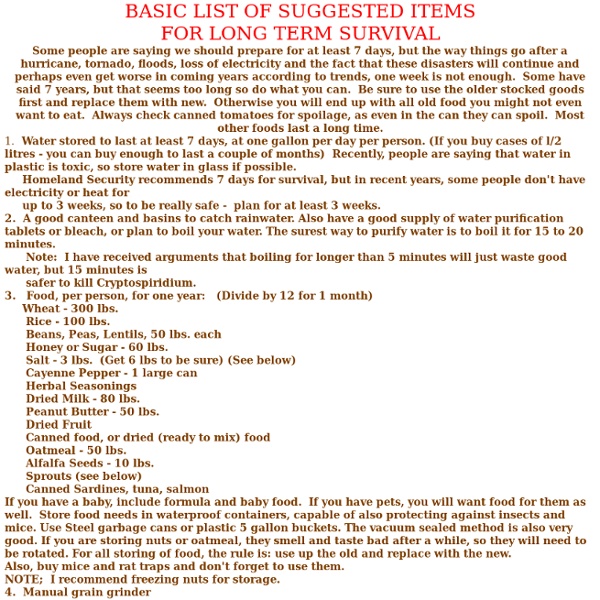100 Items to Disappear First
100 Items to Disappear First 1. Generators (Good ones cost dearly. Gas storage, risky. Noisy...target of thieves; maintenance etc.) 2. Water Filters/Purifiers 3.
Constrictor knot
History[edit] First called "constrictor knot" in Clifford Ashley's 1944 work The Ashley Book of Knots, this knot likely dates back much further.[5] Although Ashley seemed to imply that he had invented the constrictor knot over 25 years before publishing The Ashley Book of Knots,[1] research indicates that he was not its originator.[6] Ashley's publication of the knot did bring it to wider attention.[7] Although the description is not entirely without ambiguity, the constrictor knot is thought to have appeared under the name "gunner's knot" in the 1866 work The Book of Knots,[8][9] written under the pseudonym Tom Bowling.[10] in relation to the clove hitch, which he illustrated and called the "builder's knot".
Family Emergency Preparedness Kits - Living Off The Grid
Every family should have an emergency preparedness kit. In fact, we should all have several kits: One for the home, one for the car trunk… You don’t have to be expecting Armageddon, zombies or a total breakdown of society to understand the value of a family emergency preparedness kit. Think about long term power outages, earthquakes, hurricanes, snowstorms… All of these situations can leave us without access to necessities if we are not prepared. Even those who enjoy preserving food; who have a backup generator; who have their own water source… can still encounter periods of vulnerability. For instance, the pantry gets a little sparse in late spring; sometimes the diesel fuel for the generator goes bad because it hasn’t been used in years; and sometimes we’re just caught with our pants down – so to speak – for whatever reason.
The 12 Rules of Survival
The 12 Rules of Survival has been out of a couple of years now, but it never hurts to reread them. Read the whole book “ Deep Survival: Who Lives, Who Dies, and Why ” if you get an opportunity! Also, check out his new book “Lucy” at www.laurencegonzales.com !
Hidden Cache
Fishermen or hunters will keep strategically hidden supply caches so they don’t have to carry as much on their way in. A military might use larger supply caches for similar reasons. A new group of people called “preppers” may use a supply cache in conjunction with a “bug out location” to allow them an option to wait out an economic or natural disaster. I have a supply cache for gardening tools in my square foot garden, which is in a back yard a few miles from where I live.
Survive Nature - Techniques for Surviving in every Natural Environment
When you find yourself lost in the forest, you should be alert to the fact that there are predators and they are dangerous. Try to fashion a spear or knife out of branches to use as protection. Among the many predators to watch out for, bears are the most dangerous (especially Grizzlies): Black Bears: If you see a black bear 50 yards away or more, then keep your distance and continue hiking always making sure to not get closer. If you happen to come across the bear and it doesn't see you, then carefully walk away and talk loudly to alert the bear to your presence. Grizzly Bears: If you come into direct contact with a Grizzly bear, avoid eye contact.
Never Talk to the Police
By Dave Hitt on Mar 31, 2010 in Featured, Police State What’s the best response when a cop asks you something? Silence, or a short, polite non-answer. Shut up. Just.
Back to Basics, DIY Soda Can Stove
A small portable way to cook your meals while you are out backpacking and do not want to carry something heavy, using a soda can stove will allow you to boil water, cook your meal, or rehydrate your meal while on the go or in an emergency situation. There are many different types of can stoves out there, here is one version. For this version the directions were taken fromthesodacanstove.com. After looking thru many different sites and youtube and ehow, this site had the best directions, that anyone who has never made a Soda Can Stove could follow, and a lot of the other sites left you wanting more information, which we could find here. Read our comparisons of can stoves.
9 Steps To Starting A Survival Garden
In a time of economic uncertainty and rising food prices, it it always a good idea to have a garden to provide extra food for you and your family. Besides providing a source of food in an emergency, a garden is also a great source of wonderful vegetables which are MUCH healthier to eat than most of the food you can get at the supermarket. So how do you begin? The following are 9 steps that you can take to get your garden started.....



